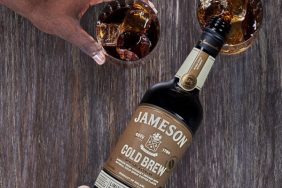Irish Whiskey is known for its smooth characteristics differentiating it from some of the smokier Scotches or sweeter Bourbons. “At the Midleton distillery, the process of triple distilling our whiskey is a key component in getting a clean spirit to age in our oak barrels,” says Jameson Brand Ambassador Caoimhe. Single Pot Still whiskey is the quintessential style of Irish Whiskey, which produces a creamy mouth feel and finish full of flavor. “This process, which is unique to Ireland, combines our malted and un-malted barley exclusively to produce some fantastic whiskeys such as Redbreast and Yellow Spot.”
Also: Aged Rum is The New Whiskey
Daniel E. Williams and his family were the first to create an Irish blended whiskey. “What was once a brilliant innovation has become the signature of almost all Irish whiskeys to this day,” says Tullamore D.E.W. Global Brand Ambassador John Quinn.
Daniel E. Williams was certainly made of the rare stuff. His earliest days in the distillery were spent shoveling malted barley and his nights were spent sleeping in the hayloft. “He was the ultimate self-made man, propelling himself quickly through the ranks.” In 1873 he became General Manager and ultimately owner of the distillery. “Single-handedly, he began to turn a good whiskey great. Some time later, this accomplished, he proudly marked every bottle from the Tullamore Distillery with the initials D.E.W.”

Tullamore D.E.W. recently celebrated the second anniversary of their new, state-of-the-art distillery in Tullamore. Irish Whiskey is the fastest growing spirits category of the last five years and if their new facility is any indication, folks like Tullamore D.E.W., Jameson and Bushmills are reaping the benefits. But, it hasn’t always been like this. Irish Whiskey has taken a much different path than its Scottish counterparts.
Even before the original distillery was built in 1829, Tullamore was home to a bizarre historical tragedy. On Tuesday May 10th, 1785, the town was the scene of a hot air balloon crash. “It resulted in a fire that burned down over 100 houses in the center of the town, and gave Tullamore the unusual distinction of being the home of the world’s first aviation disaster,” says Quinn.

Although the event devastated the town, in true Irish spirit, the people came together and rebuilt. “Thankfully, there was no loss of life, and it gave the town an opportunity. Instead of letting the incident define the town, the people of Tullamore saw a space for development and a chance to rebuild, like a phoenix from the ashes.”
To this day, the town shield depicts a phoenix rising from the ashes. “The crash, and the spirit of the people in its aftermath, is commemorated annually by the Phoenix Festival, with hot air balloons from Ireland and the UK coming to the town to celebrate new beginnings.” Although it didn’t have an impact on the whiskey as company was founded four decades later, the distillery was built on part of the area destroyed by the fire.

The first drop of Jameson Irish whiskey was distilled back in 1780, five years before the Tullamore hot air balloon crash. John Jameson opened his Bow Street Distillery at Smithfield in the heart of Dublin. “This Bow Street distillery was to become a city within a city, employing over 300 coopers, engineers, distillers and millers. Jameson fast became one of the bestselling Irish whiskeys, earning a reputation for its use of quality ingredients and triple distilled, copper pot still smoothness.,” says Henderson.
During the Industrial Revolution, Irish whiskey production quickly became a model of Victorian enterprise. “However, Irish whiskey was to be dealt a series of devastating blows,” says Jameson Brand Ambassador Greg Slattery. The Irish Famine saw the deaths of over one million Irishmen. This also led to another million fleeing the country for America and other more enticing destinations. “The thirst for Irish Pot Still whiskey continued to spread throughout Europe and the USA with displaced emigrants seeking a liquid memory of home.”

Reveling in their success, Irish distillers did not recognize the opportunity presented by Aenus Coffey, founder of the Coffey Still. “Having been rejected by Irish distillers, Coffey brought his invention to Scotland where it was welcomed with open arms as a cheaper and more efficient way to make whiskey than that made in a traditional copper pot still.”
As the 20th century began, two completely unrelated events led to the demise of the Irish Whiskey category almost completely. The events were Prohibition in America and the Irish War of Independence and subsequent Civil War. “Irish whiskey production grinded to a halt overnight as the door to its two main markets was closed,” says Henderson. By the mid 1960s, only three distilleries were still in production in the newly formed Republic of Ireland. These distilleries were Jameson, Powers and Cork Distillery Company. “In the face of extinction, these three companies amalgamated to create Irish Distillers Limited.” They began making blends with Jameson quickly emerging as a reference in Irish whiskey, turning peoples’ attention back to Irish whiskey.
American Prohibition
In 1919, Congress passed the Volstead Act which made the production, sale and consumption of alcohol illegal in the USA. “Overnight one of Irish whiskey’s main lifelines was cut,” says Slattery. “Bootleggers cashed in on the dwindling supplies of Irish whiskey and when it ran out, began filling bottles with poor quality, diluted alcohol selling it as Irish whiskey.” This practice greatly discredited the reputation of Irish whiskey which had enjoyed such success prior to Prohibition.
A Return to Greatness
Irish whiskey is currently enjoying a renaissance period as people have begun to have a real thirst for the category once again. “The recent emergence of several new distilleries on the island has peaked curiosity around the category,” says Slattery. In 2012, there were only four operating distilleries on the island of Ireland but this figure is due to rise to fifteen in the next couple of years. “More established brands such Jameson continue to innovate too with its recent launch of Jameson Caskmates; a whiskey aged in craft beer barrels which has caused a lot of excitement in many countries.”








